Time for a second revision, this time with known part numbers:

This is the list of LEDs used, from left to right:
---------------------------------------------------------------------------------------------------------------------------------------------
# Colour Reichelt part peakwl Vf min typ max Crystal material Angle Brightness Manufacturer part number Notes
---------------------------------------------------------------------------------------------------------------------------------------------
0 IR SFH 4346 950 nm - 1.6 1.9 V ? 20° Osram OS SFH 4346 Tinted
1 IR SFH 4356P 860 nm - 1.7 2.0 V ? 20° Osram OS SFH 4356P Tinted
2 red RND 135-00006 700 nm 1.8 - 2.6 V GaP 40° 10 mcd RND RND 135-00006 Tinted
3 red LED 3-3500 RT 660 nm - 1.85 2.5 V GaAlAs 50° 2300 mcd Kingbright L-934SRC-J4
4 red LED 3-4500 RT 660 nm - 2.1 2.5 V AlGaInP 34° 4500 mcd Kingbright L-7104SRC-J4
5 red EVL 264-7SDRC 650 nm 1.7 2.0 2.4 V AlGaInP 40° 100 mcd Everlight 264-7SDRC/S530-A3
6 red KBT L-7104SURC 640 nm - 1.9 2.5 V AlGaInP on GaAs 34° 2500 mcd Kingbright L-7104SURC-E
7 red KBT L-7104SEC-H 635 nm - 2.2 2.8 V AlGaInP 34° 1000 mcd Kingbright KBT L-7104SEC-H
8 red VIS TLHR 4900 635 nm - 2.0 3.0 V GaAsP on GaP 16° 13 mcd Vishay TLHR 4900
9 red SLK 3MM RT 627 nm - 2.0 2.5 V GaAsP on GaP 50° 60 mcd Kingbright L-934EC
10 green WUE 151034GS0300 525 nm - 3.2 3.8 V InGaN 30° 10000 mcd Würth 151034GS03000
11 orange LED 3-7800 OR 611 nm - 2.2 2.8 V AlGaInP 34° 7800 mcd Kingbright L-7104SEC-J4
12 orange LED 3-3000L ONG 605 nm 1.6 2.0 2.4 V ? 20° 3000 mcd Lucky Light LL-304UAC2E-4AC
13 yellow LED 3-2800 GE 590 nm - 2.0 2.5 V AlGaInP 34° 2800 mcd Kingbright L-7104SYC-J3
14 yellow NTE NTE30032 592 nm - 2.0 2.4 V AlGalnP on GaAs 10° 2500 mcd NTE NTE30032
15 yellow LED 3-1300 GE 595 nm - 2.0 2.4 V AlGaInP 50° 1300 mcd Kingbright L-934SYC
16 ? VIS TLHY 4205 585 nm - 2.4 3.0 V GaAsP on GaP 22° 20 mcd Vishay TLHY 4205 Tinted, does not light up
17 yl-green KBT L-7104MGC 574 nm - 2.1 2.5 V AlGaInP 34° 700 mcd Kingbright L-7104MGC
18 yl-green KBT L-7104GC 565 nm - 2.2 2.5 V GaP 34° 60 mcd Kingbright L-7104GC
19 green LED 3-14000 GN 520 nm - 3.2 4.0 V InGaN 34° 14000 mcd Kingbright L-7104ZGC-G
20 red WUE 151034RS0300 628 nm - 2.0 2.6 V AlGalnP 30° 2600 mcd Würth 151034RS03000
21 green EVL 204-10 UBGC 502 nm - 3.5 4.3 V InGaN on SiC 20° 50 mcd Everlight 204-10 UBGC/S400-A6
22 trqouise RND 135-00151 500 nm 2.6 3.2 3.6 V ? 30° 8500 mcd RND RND 135-00151
23 blue LED 3-3700 BL 465 nm - 3.3 4.0 V InGaN 20° 3700 mcd Kingbright L-7104VBC-D
24 IR BPW 34 Si 65° Vishay BPW34 PD 600-1050 Peak 900 nm
25 blue LED 3-2000 BL 465 nm 2.9 3.3 3.6 V InGaN 30° 2000 mcd ? L-314BC-A3
26 blue LED 3-3000 BL 458 nm - 3.2 3.7 V InGaN 20° 3000 mcd Kingbright L-7104QBC-G
27 blueish EVL 1254UBC 428 nm 3.0 3.8 4.5 V GaN on SiC 40° 400 mcd Everlight 1254UBC
28 UV LED LL 3-120 VI 400 nm 2.8 3.2 3.8 V InGaN 20° 120 mcd LuckyLight LL-304UVC4B-Q5D
29 green KBT L-7113ZGC 515 nm - 3.3 4.1 V InGaN on Sapphire 20° 14000 mcd Kingbright L-7113ZGC 5 mm
Sensitivity measurements were done exactly as in the first revision of the experiment, as explained in the Project Details. As I changed lab in the meanwhile, I cannot use the spectrometer anymore, therefore no measurements of the emission spectra this time. The peaks drawn in red denote the peak wavelength given in the respective datasheets.
All parts were sensitive to direct sunlight, but with varying orders of magnitude of their discharge times. Therefore, some parts are not sensitive enough for this experiment, other parts are highly sensitive, but for wavelengths outside of the range of my monochromator.
Data is sorted for emission wavelength.
Infrared:
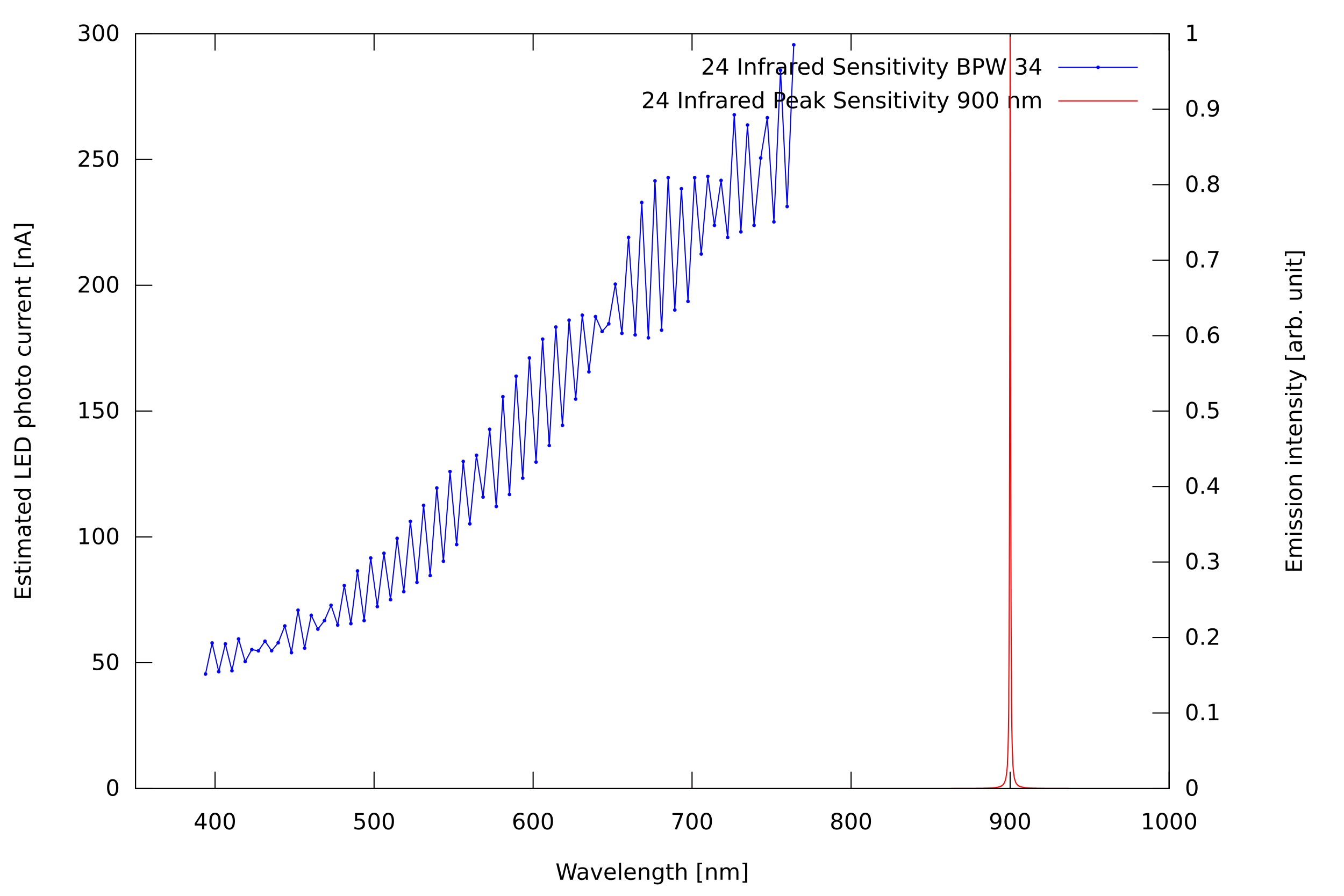 BPW34 is the same photodiode as in the first run of the experiment, which is sensitive to the complete visible range. Datasheet claims best sensitivity between 600 and 110 nm, with a peak at 900 nm.
BPW34 is the same photodiode as in the first run of the experiment, which is sensitive to the complete visible range. Datasheet claims best sensitivity between 600 and 110 nm, with a peak at 900 nm.The flicker artifact is quite strong in this measurement, but the general shape of the sensitivity is clearly visible and comparable to the first run of the experiment.

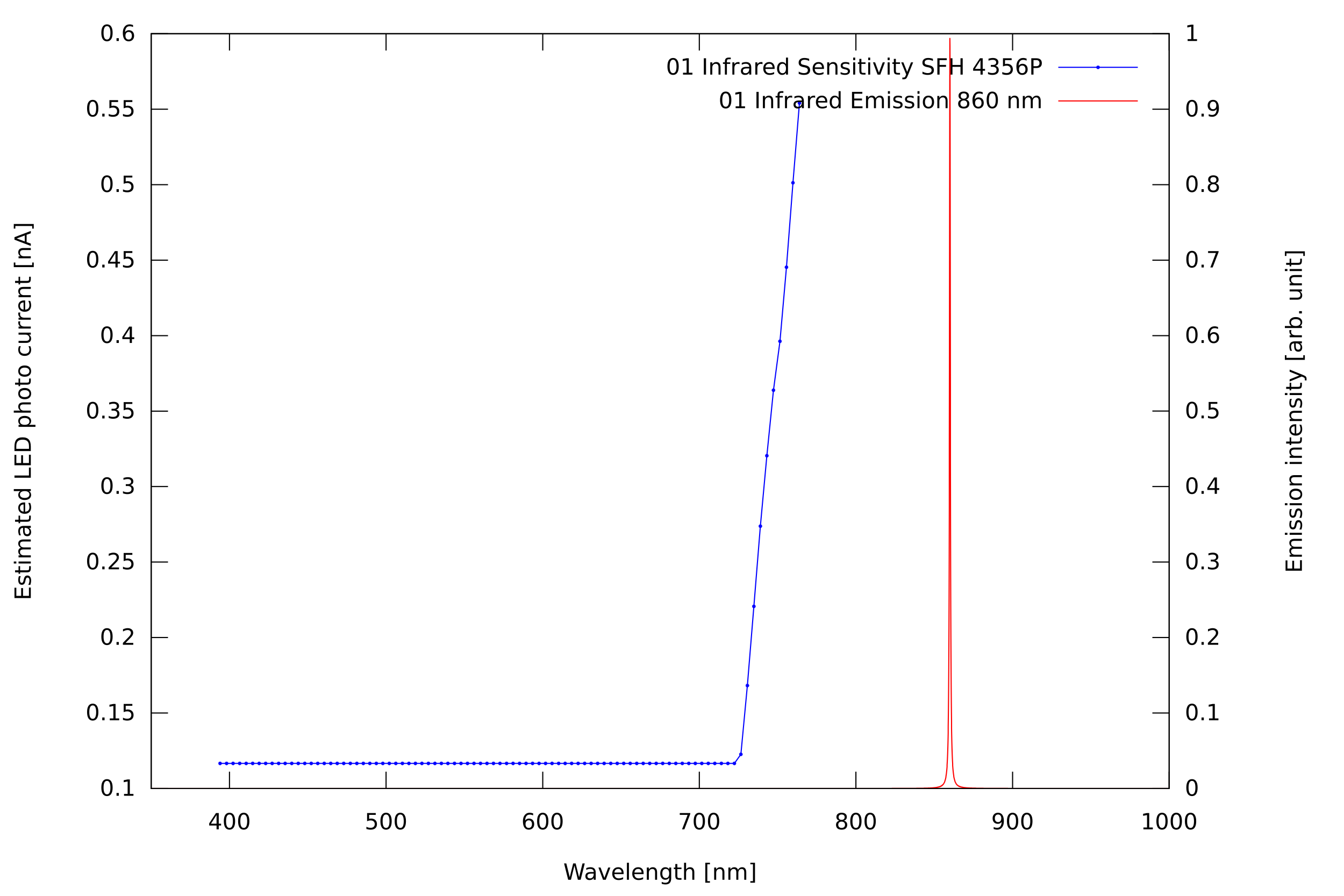
These two infrared LEDs in tinted housing are sensitive to wavelengths > 700 nm, mostly outside the range of my monochromator. On the first experiment, I used IR LEDs in clear housing, which had a broader sensitivity, extending in the visible range.
Visible red:
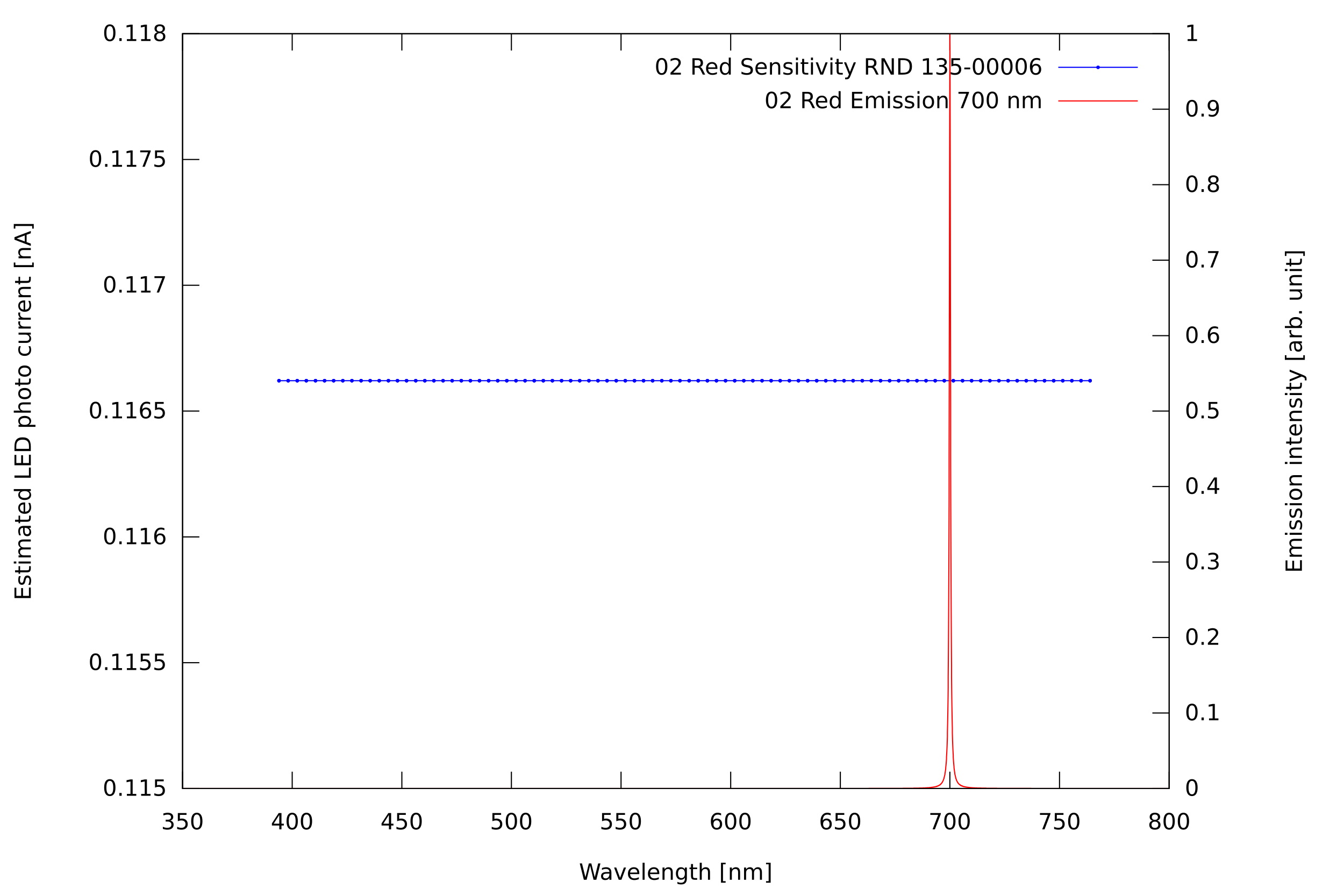
This one is quite insensitive, no sensitivity data could be measured.
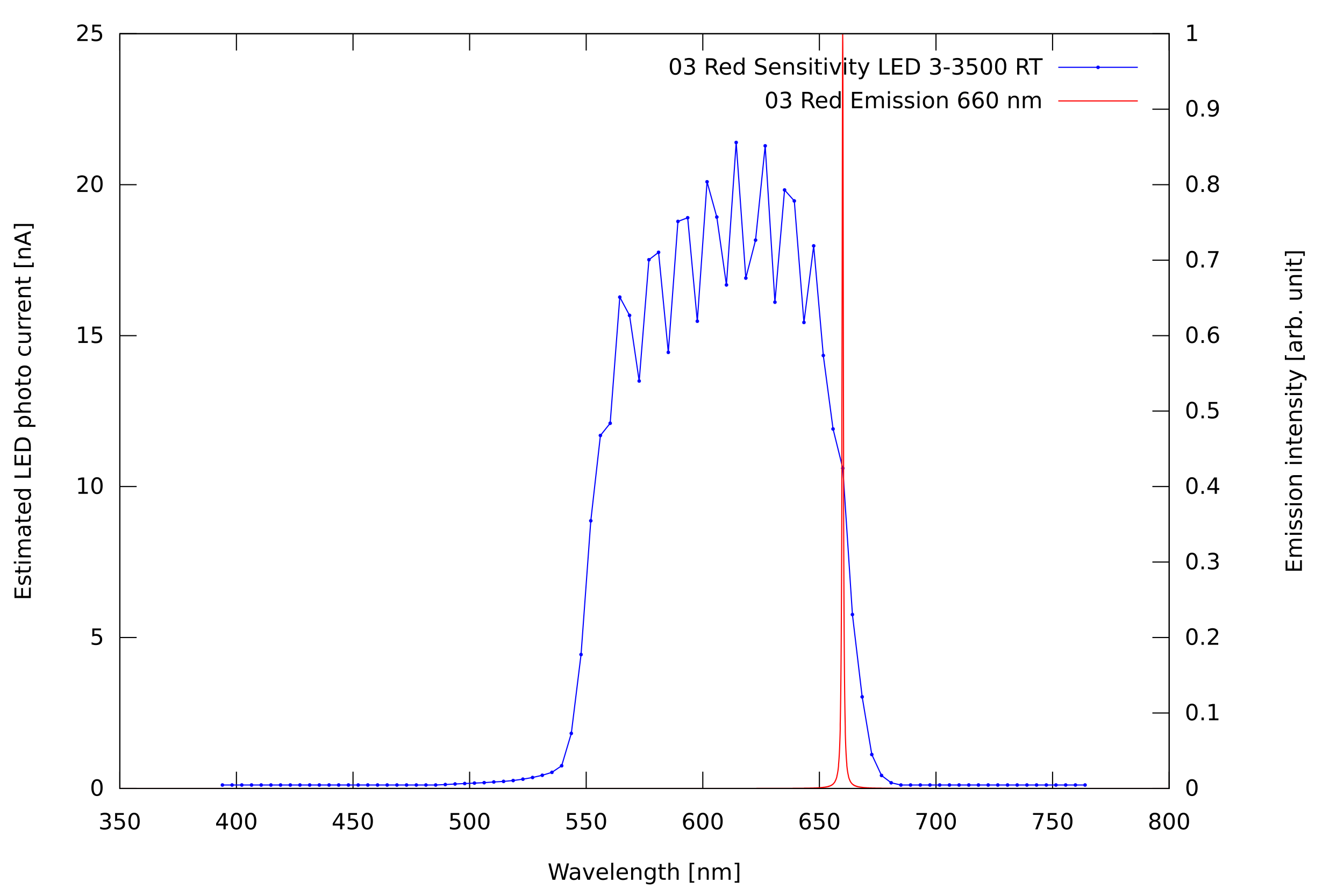
Sensitive for green to red, with a distinctive photo current.
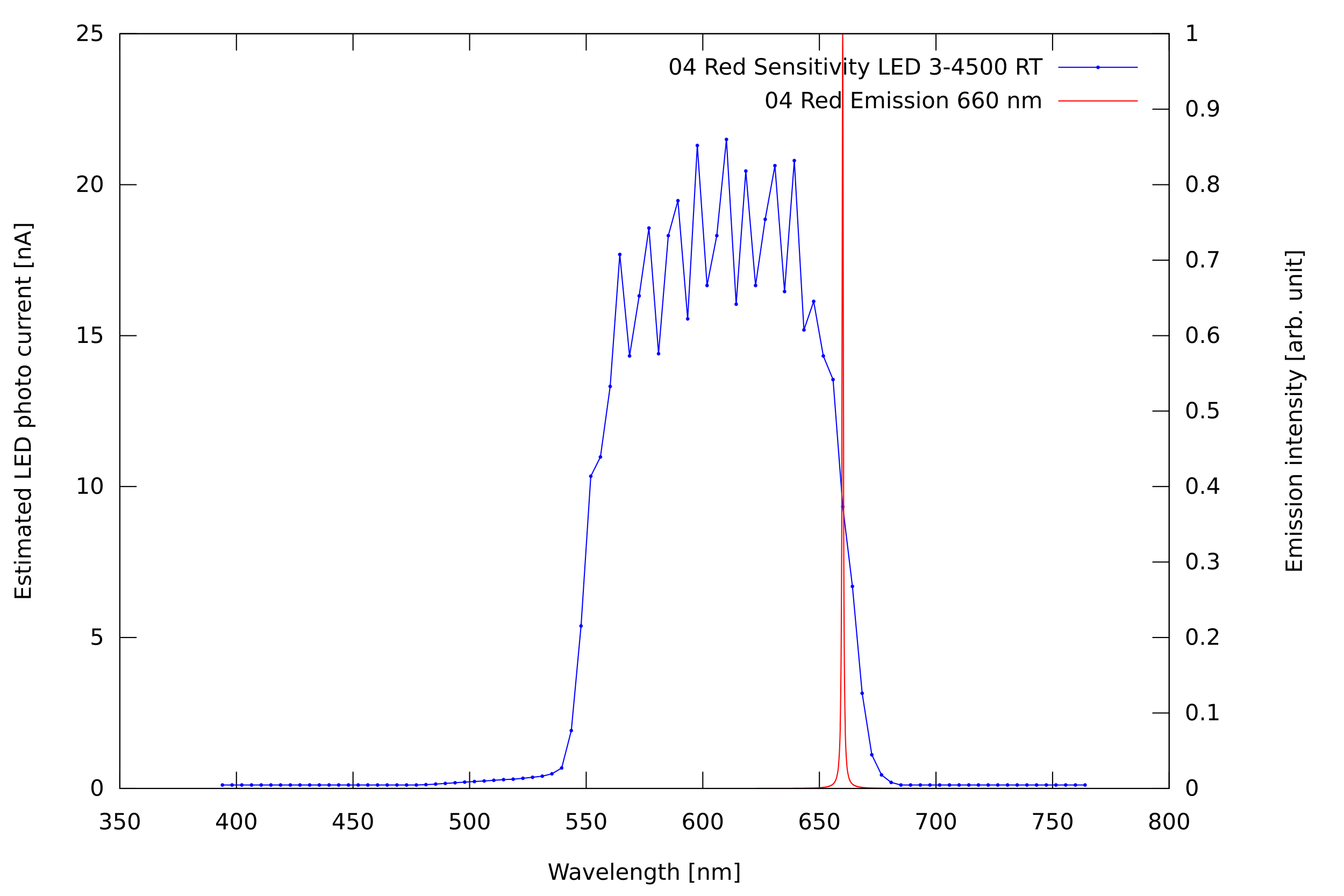
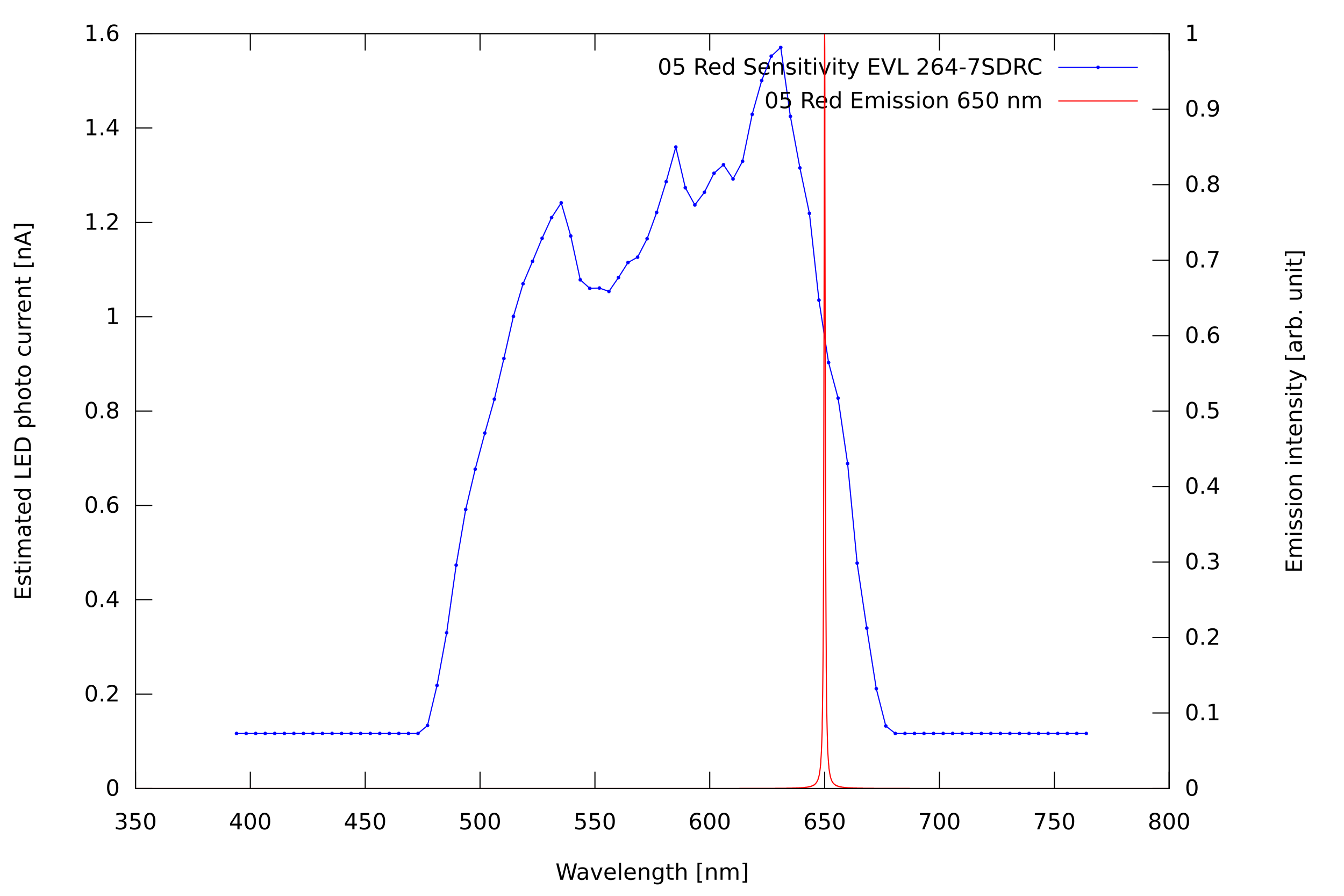
This red LED can see blue to red light, with a low photo current.
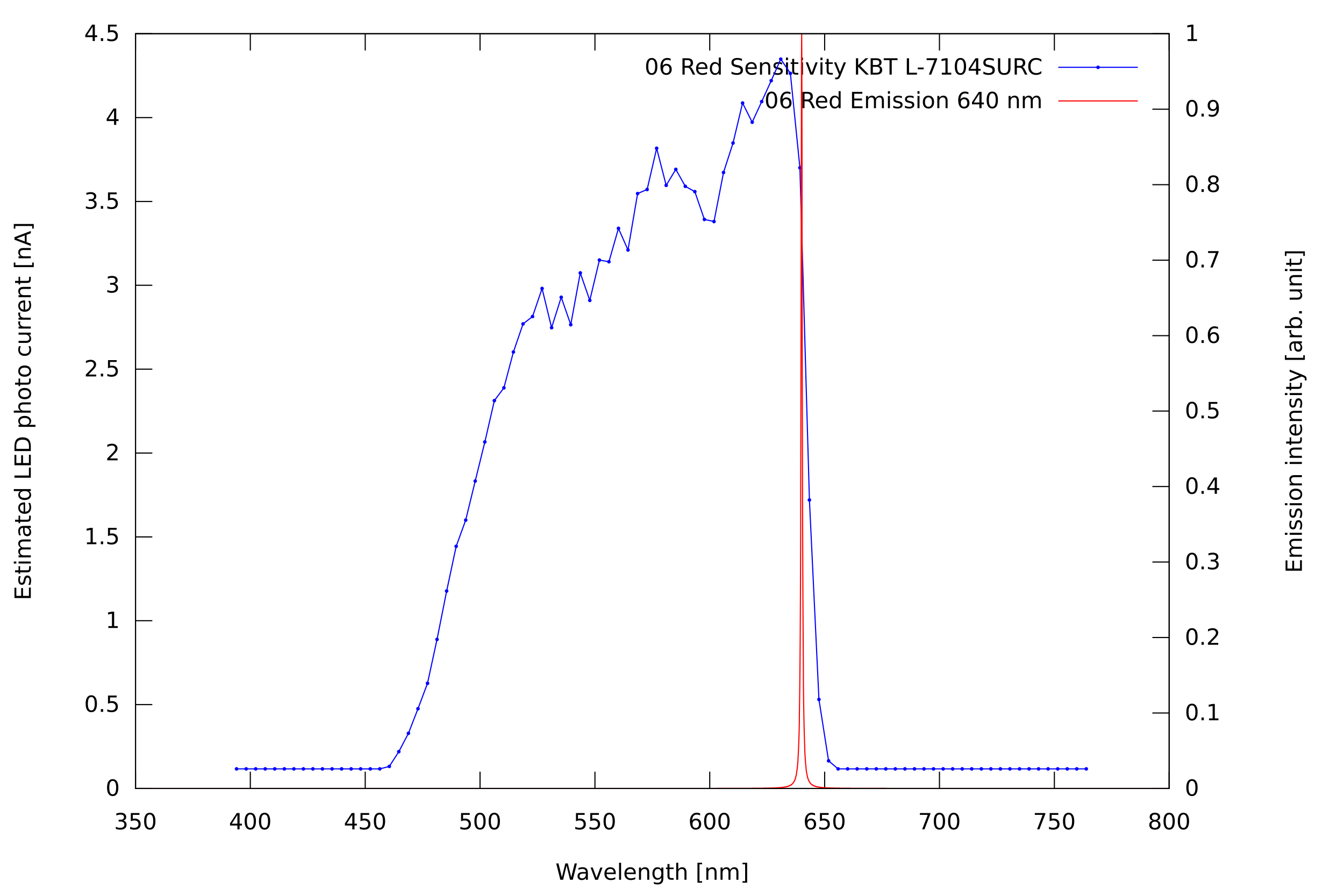
Similiar to 05, but with a larger photo current.
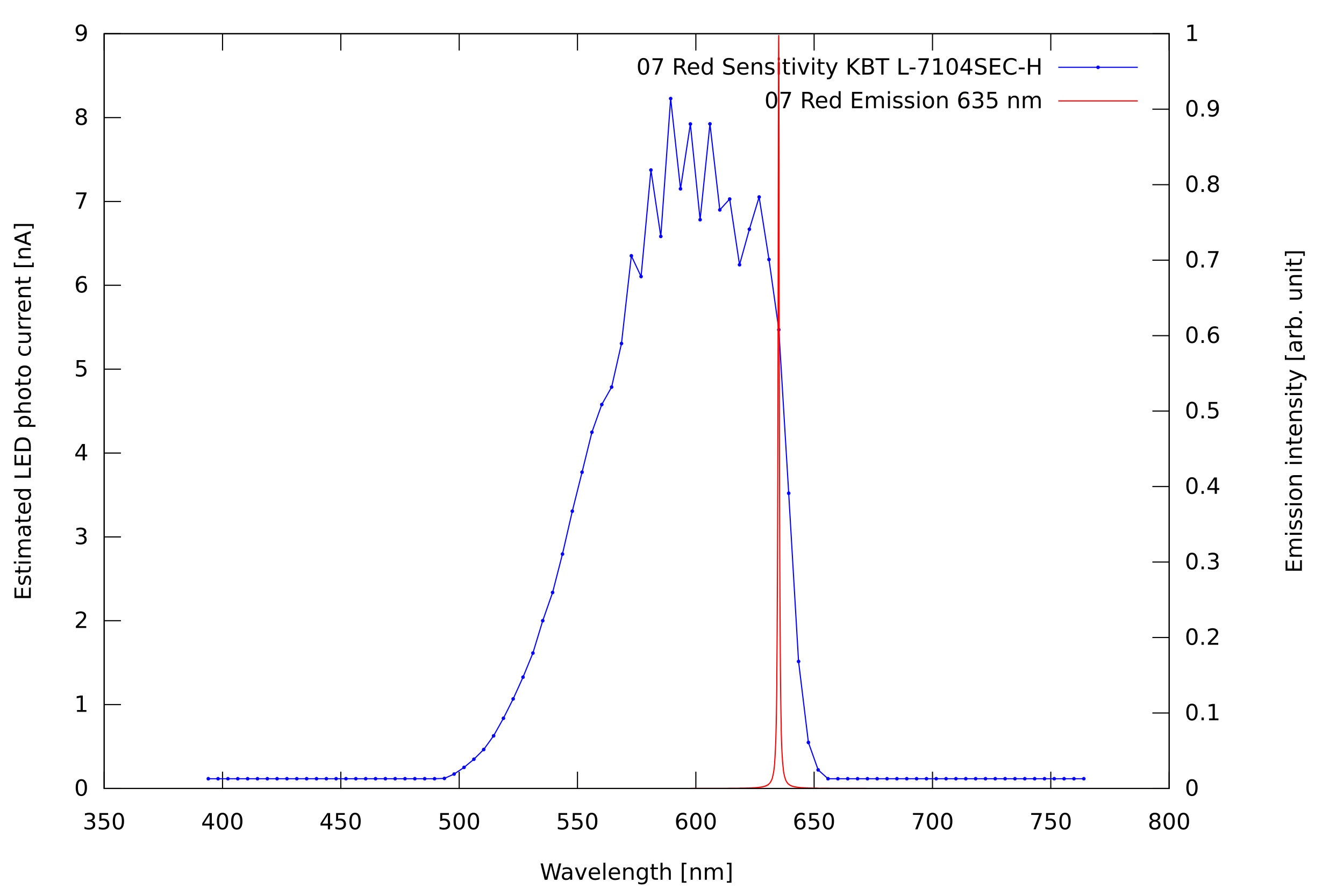
Sensitive for green to red, strong photo current.
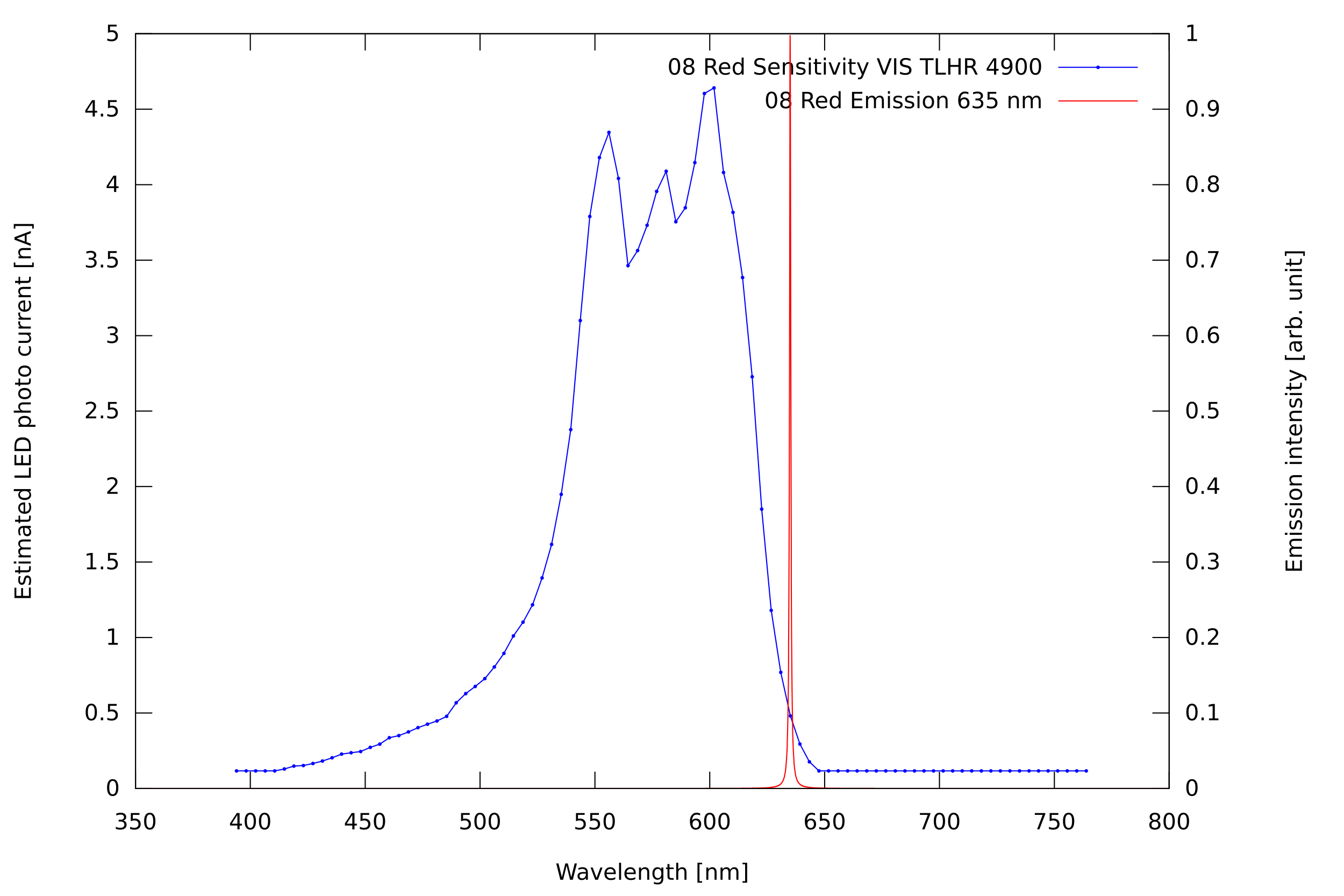
Sensitive for green to red.

The most narrow bandwidth red LED in this experiment, sensitive for orange and red. There is a small additional peak at green wavelengths, but with much lower sensitivity.

Sensitive for yellow-green to red.
Visible orange to yellow:

Sensitive for yellow-green to orange.
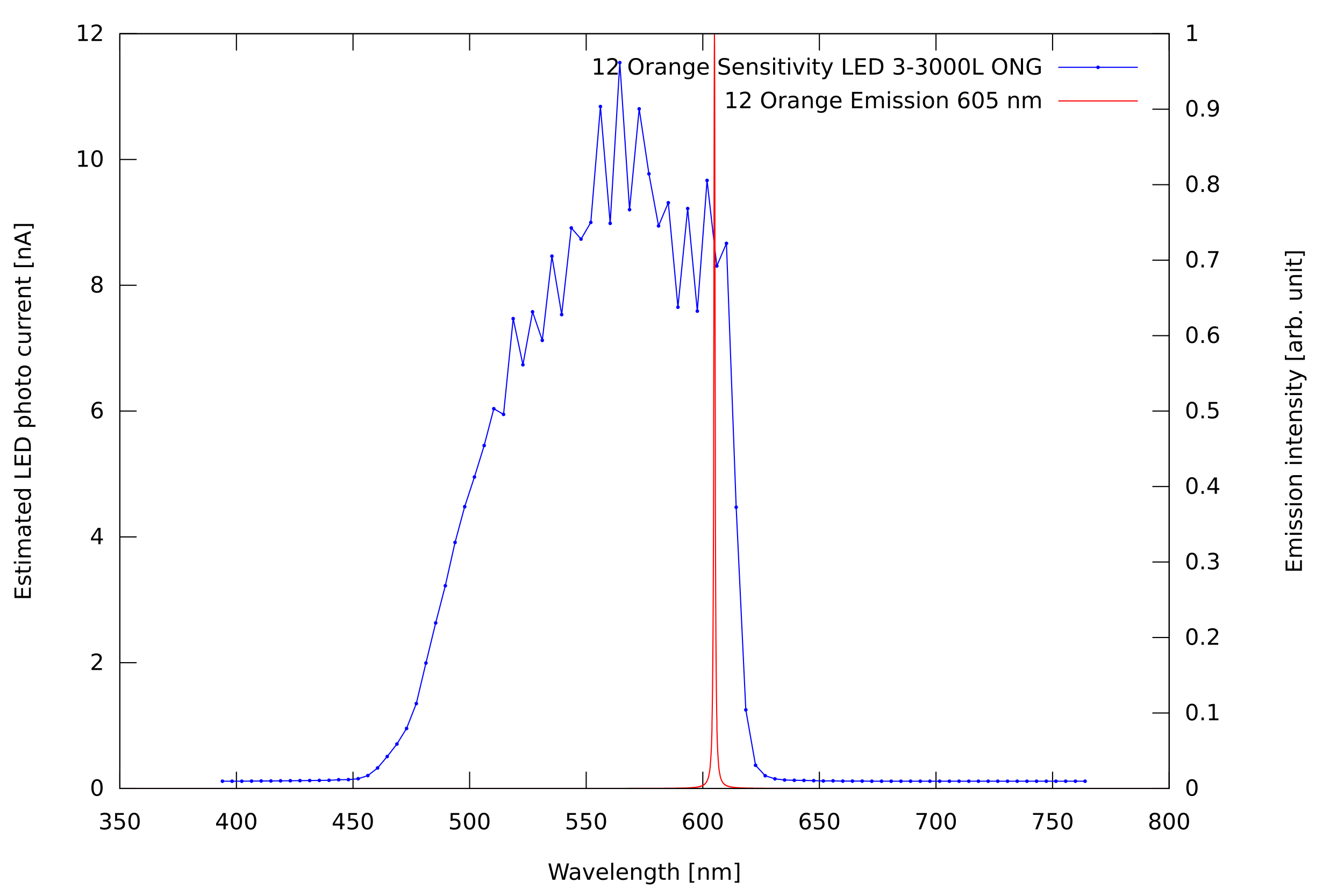
Large bandwidth from blue to orange.
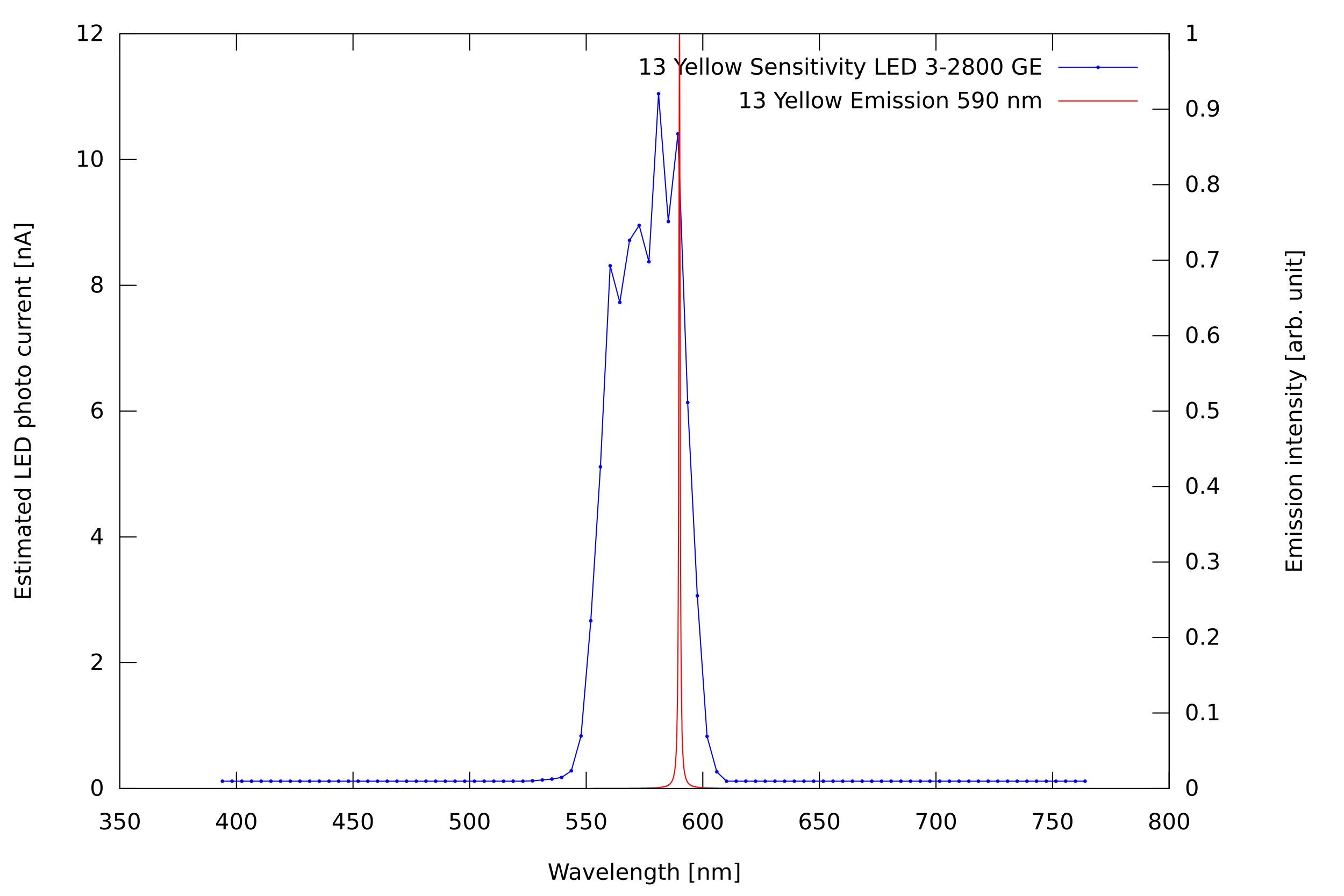
Sensitive for yellow-green to orange.
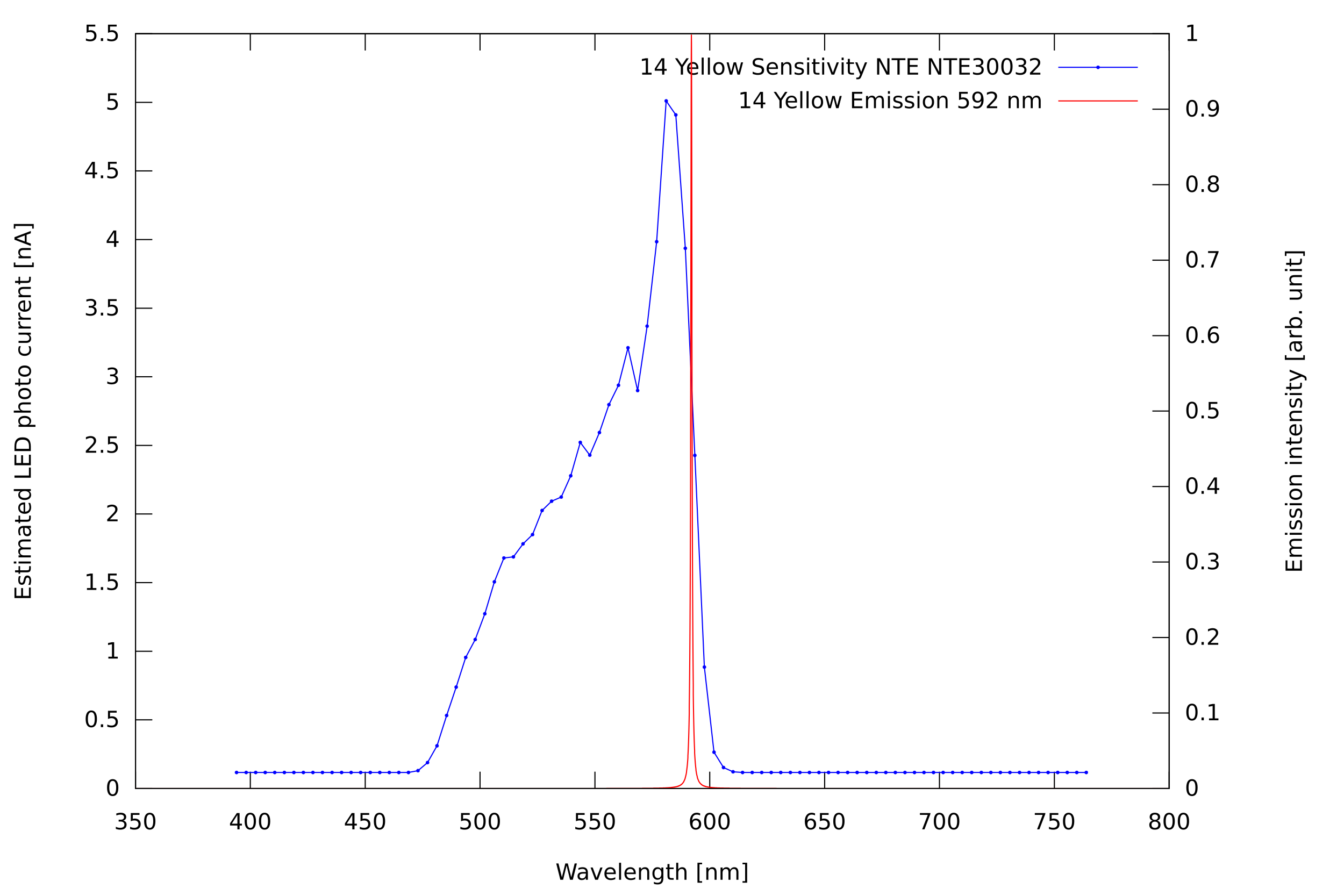
Sensitive for blue to yellow, but with an interesting shape of the sensitivity spectrum. Maybe this is a mixed material crystal ?
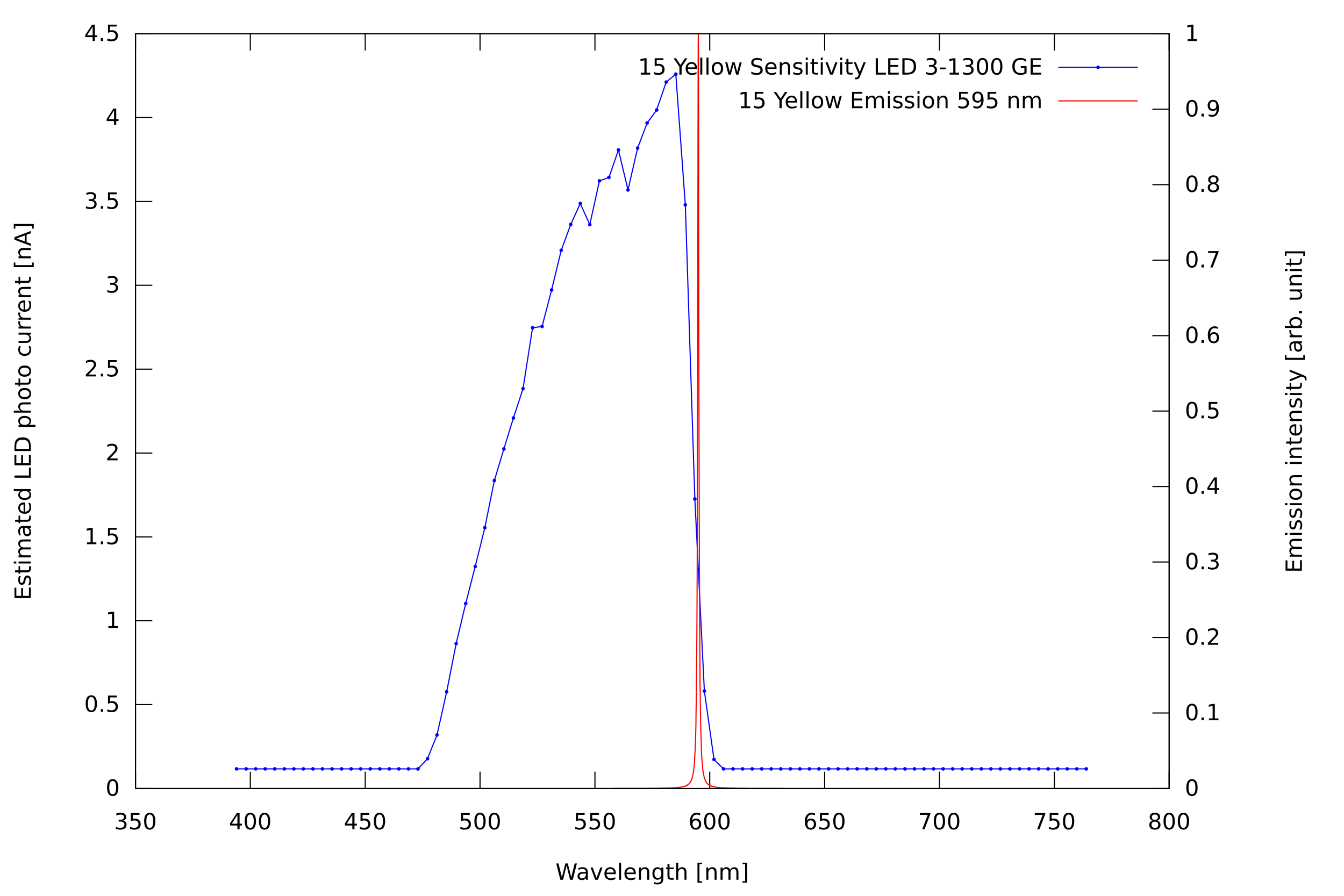
Similiar to 14, but with a less sharp peak.

This LED was sensitive to direct sunlight, but did not light up with 3.3V, which denotes an unusual high Vf for a yellow LED. Perhaps this is an indirect bandgap crystal, sensitive to ultraviolet only ? I had a similiar case in the first run of the experiment, in which a red LED was UV sensitive, but due to lack of data, this is an hypothesis only. Do not use this one for now, its strange.
Visible yellow-green to ultraviolet:
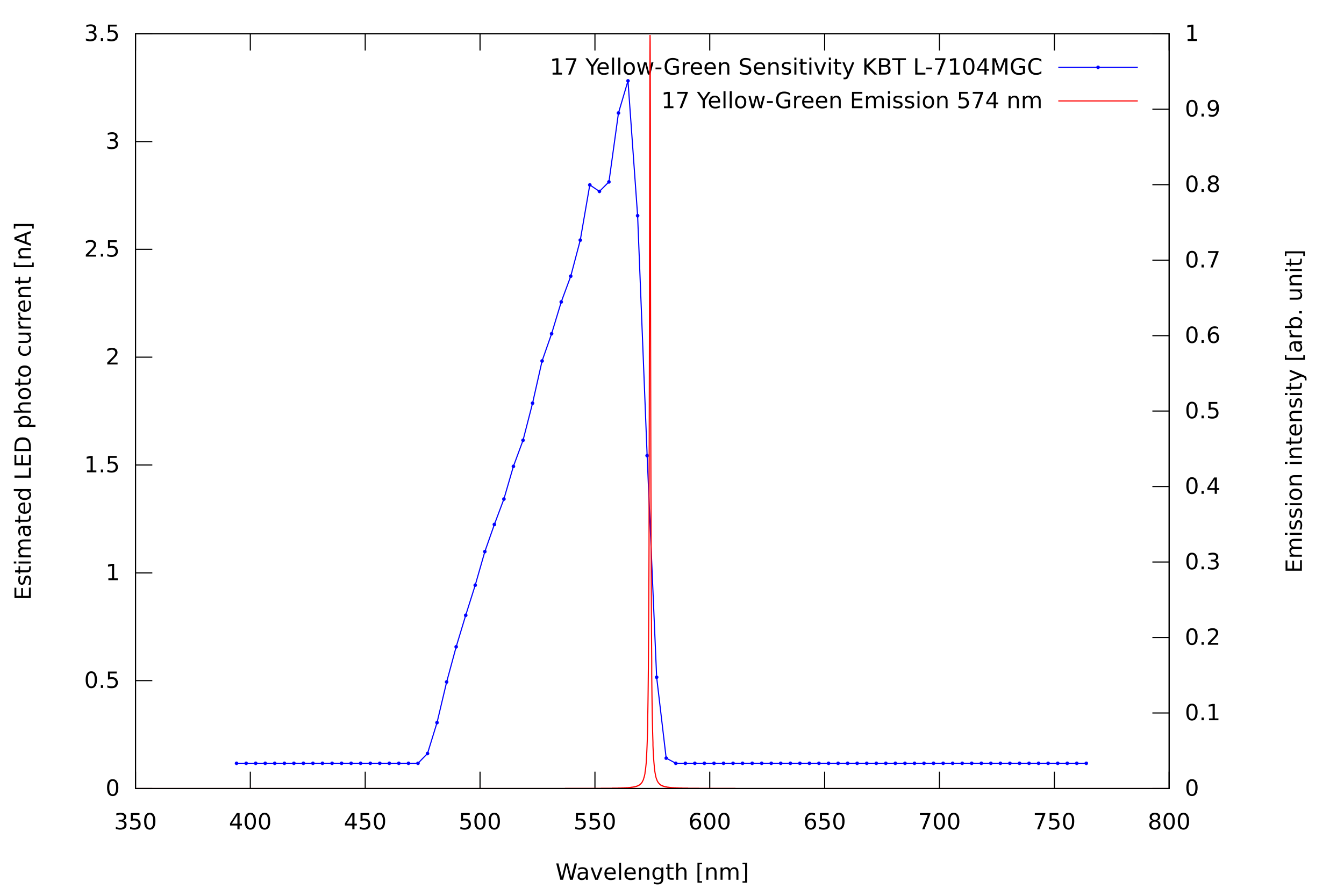
Sensitive for blue to green.
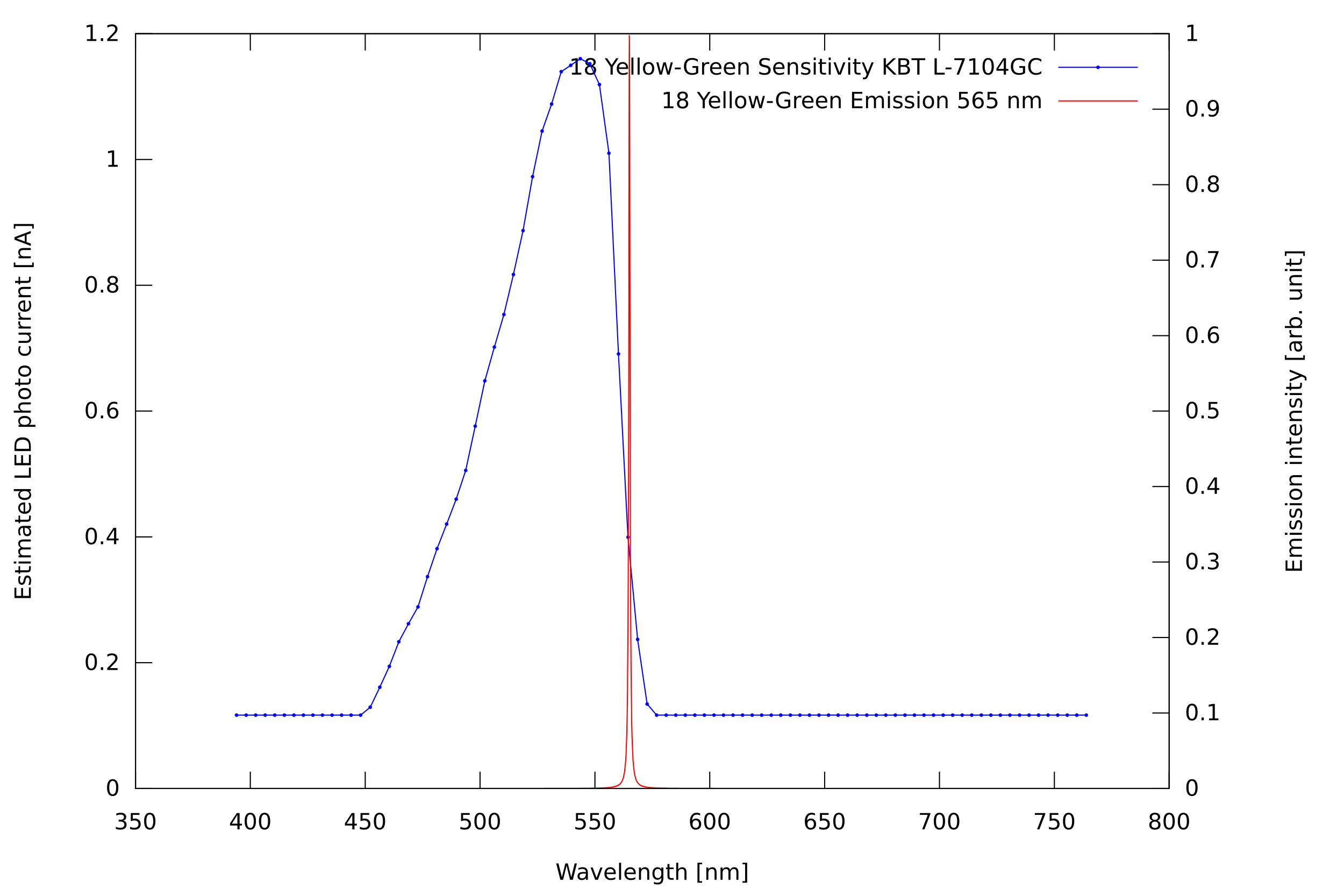
Both yellow-green LEDs 17 and 18 are direct bandgap semiconductors as all LEDs shown before, which are sensitive to their own emission. 17 has narrower bandwidth and a higher photo current than 18, otherwise they are similiar.
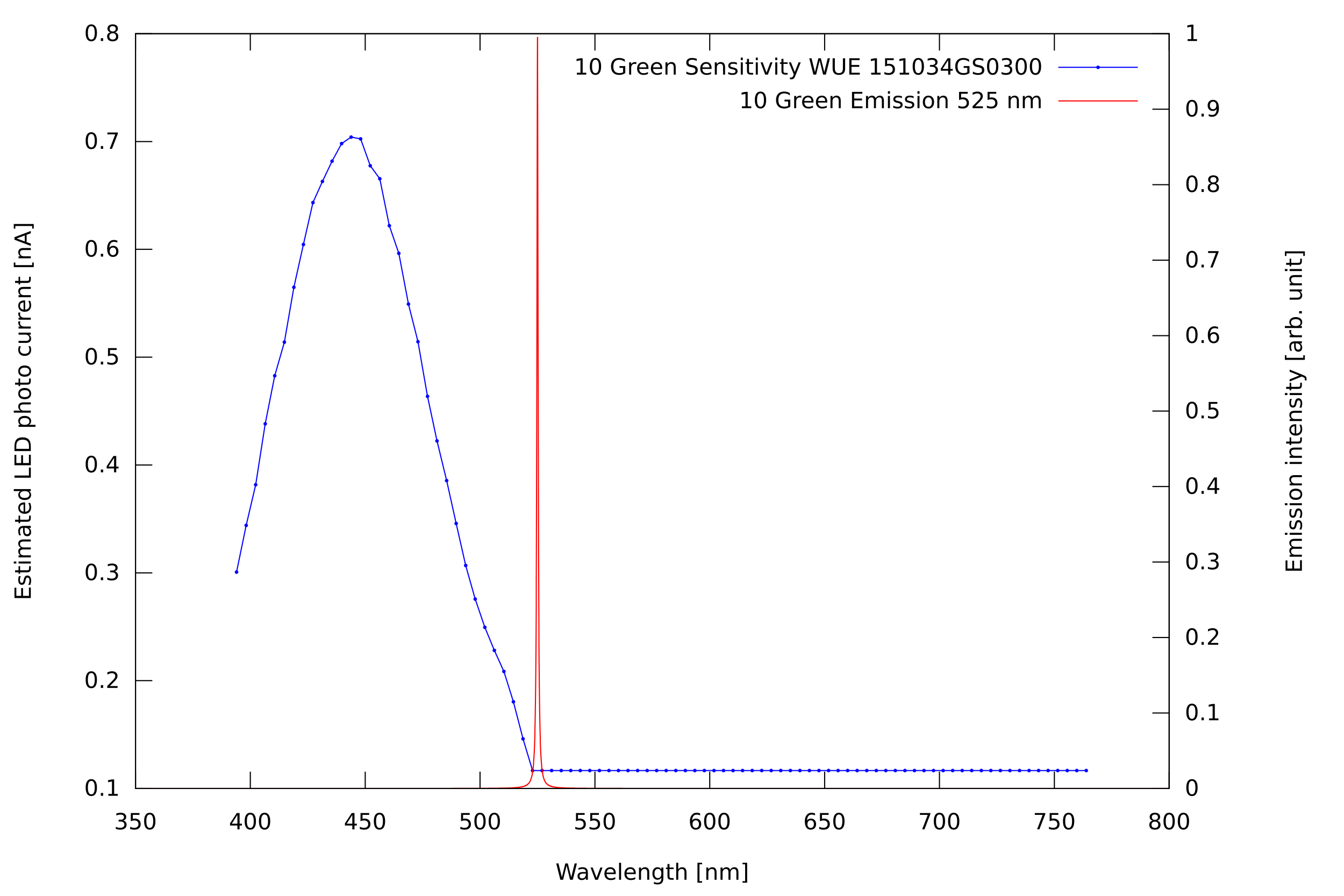
Sensitive from UV to blue-green. From now on, the LEDs are indirect bandgap semiconductors, which are not sensitive to their own emitted colour.
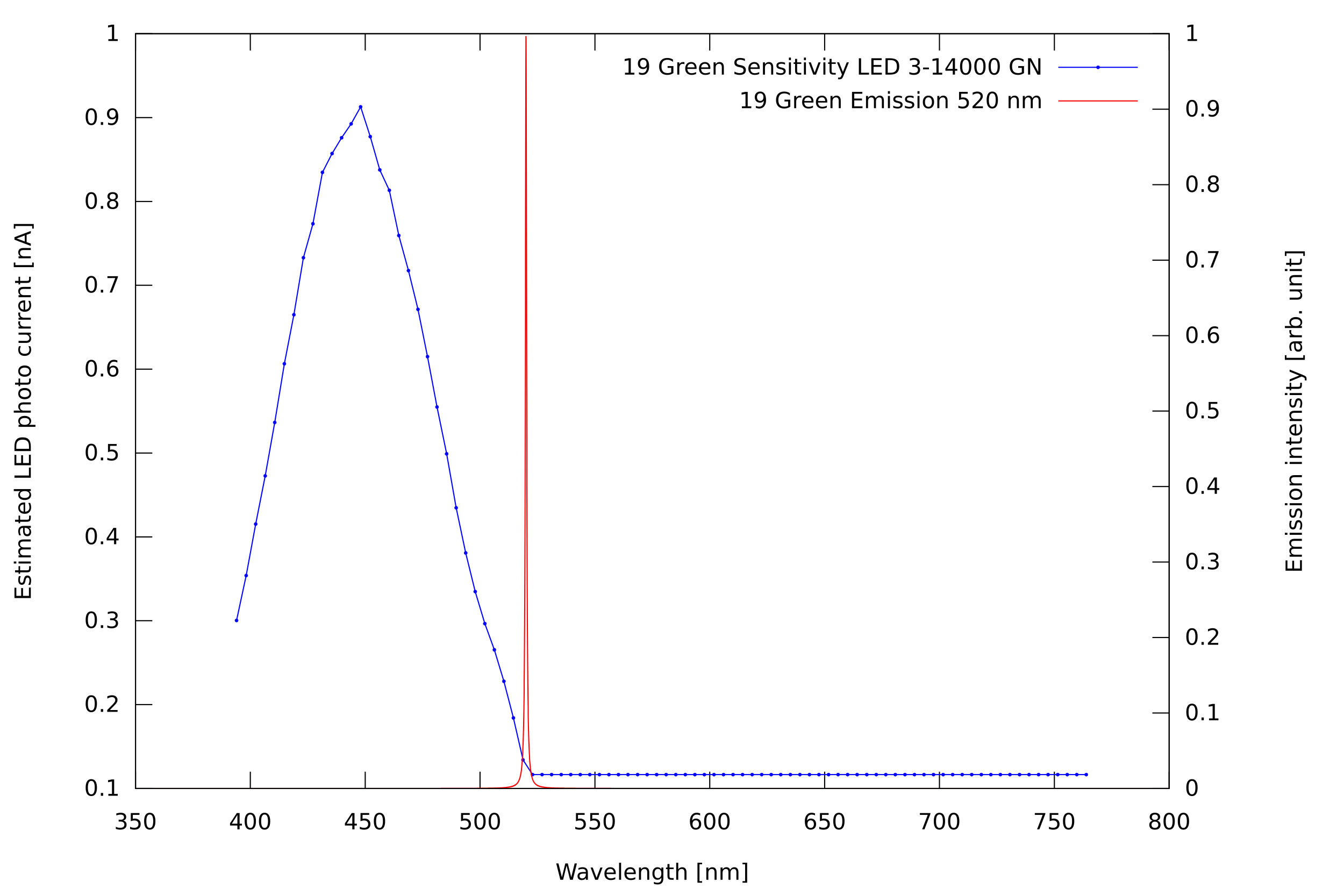
Similiar to 10, but with a larger photo current.

This is a 5 mm LED, because the peak wavelength of 515 nm was not available in 3mm housing at Reichelt. Its sensitivity is similiar to 19.
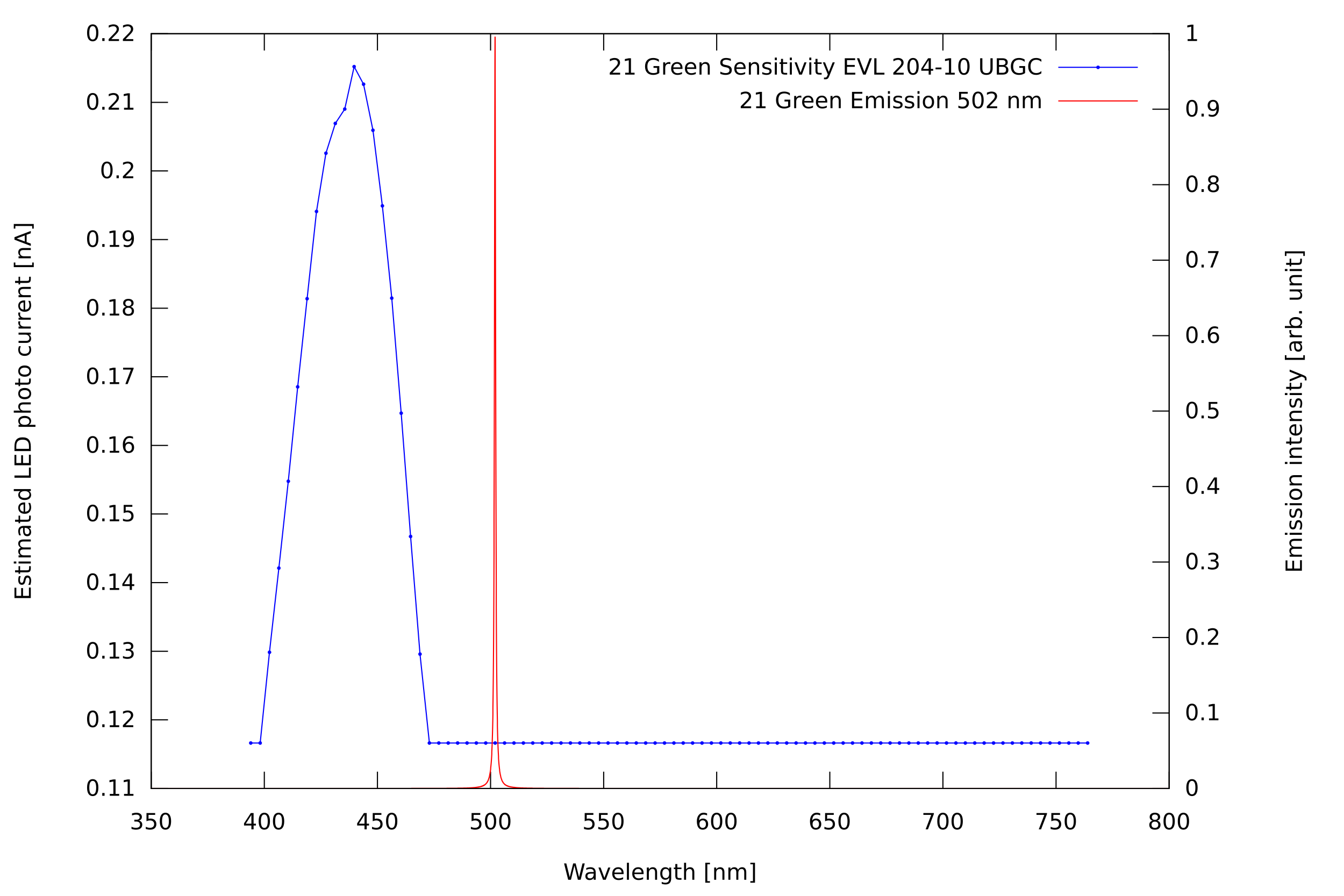
Sensitive for UV to blue only, narrow bandwidth, low photo current
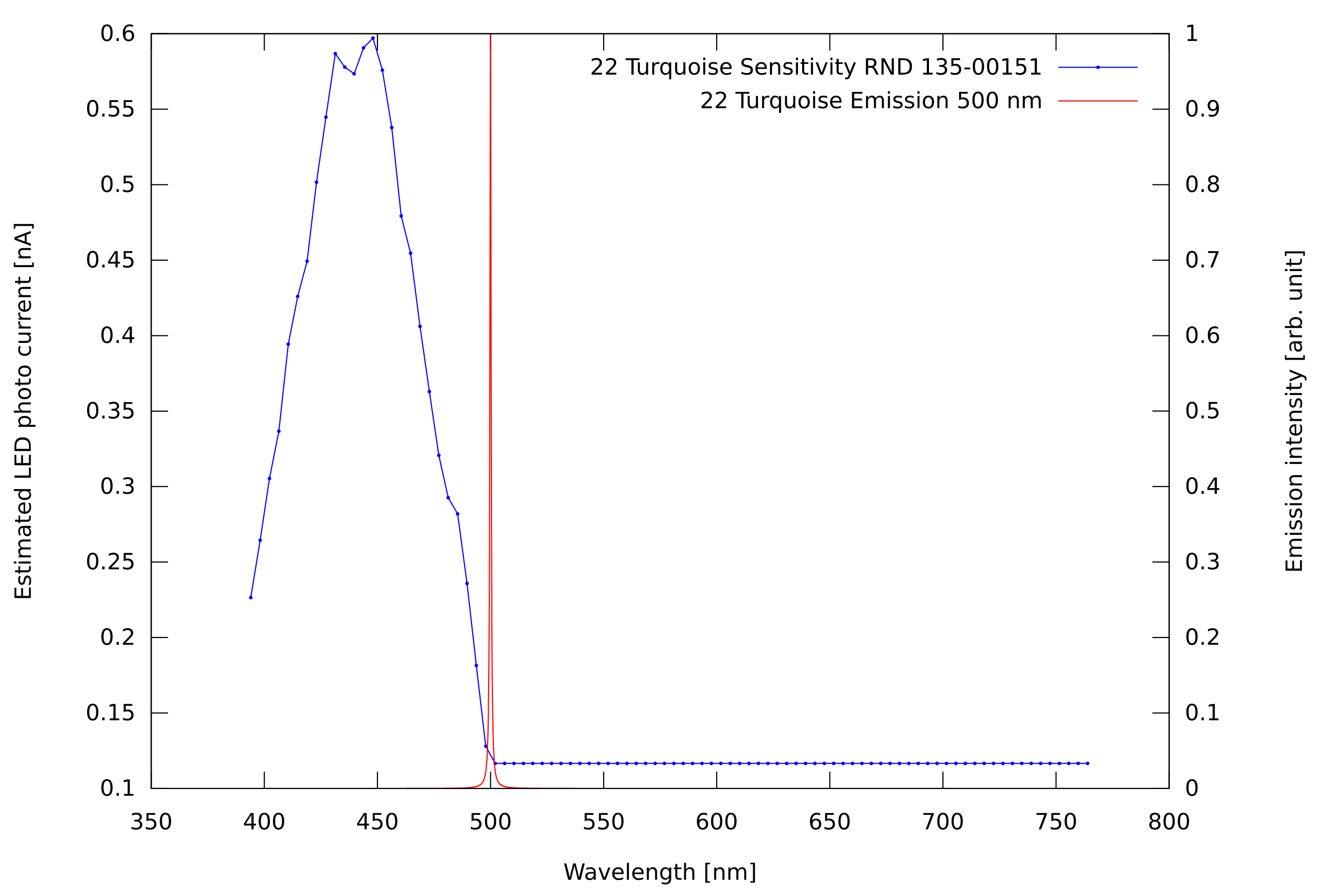
Emitting a very nice colour looking turquoise, this LED is sensitive from UV to blue-green.
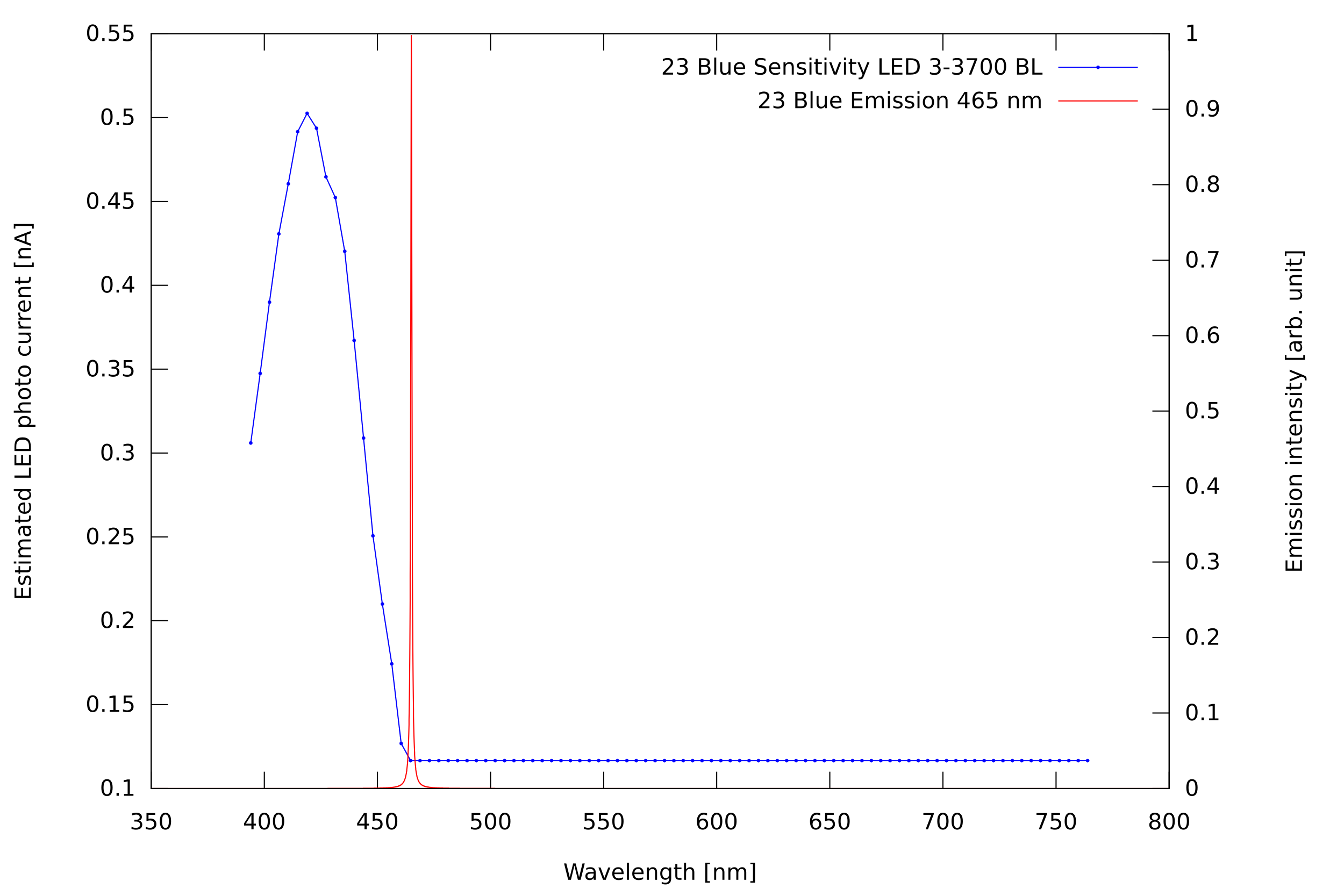
Sensitive for UV to deep blue.
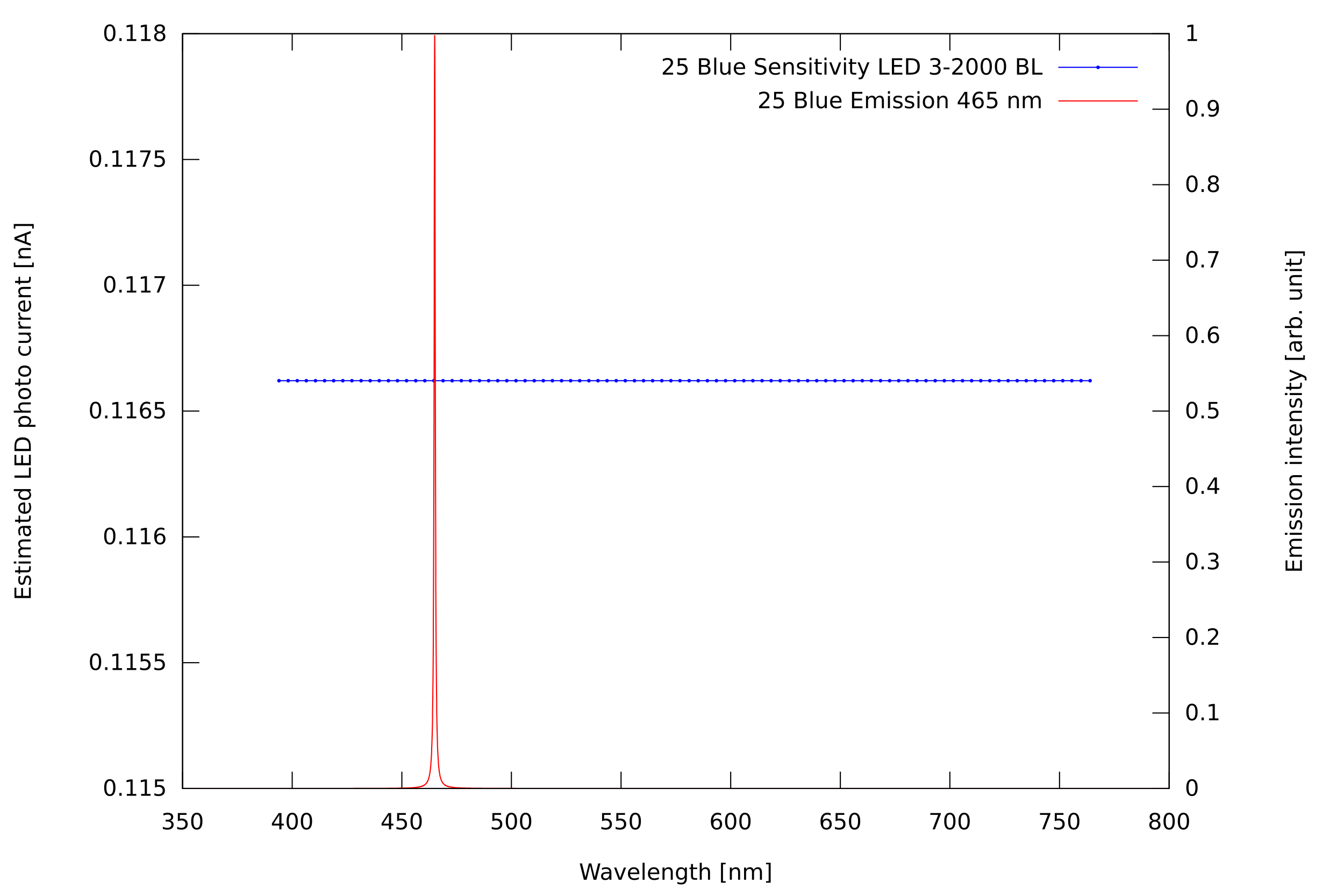
This blue LED is too insensitive for measurement.
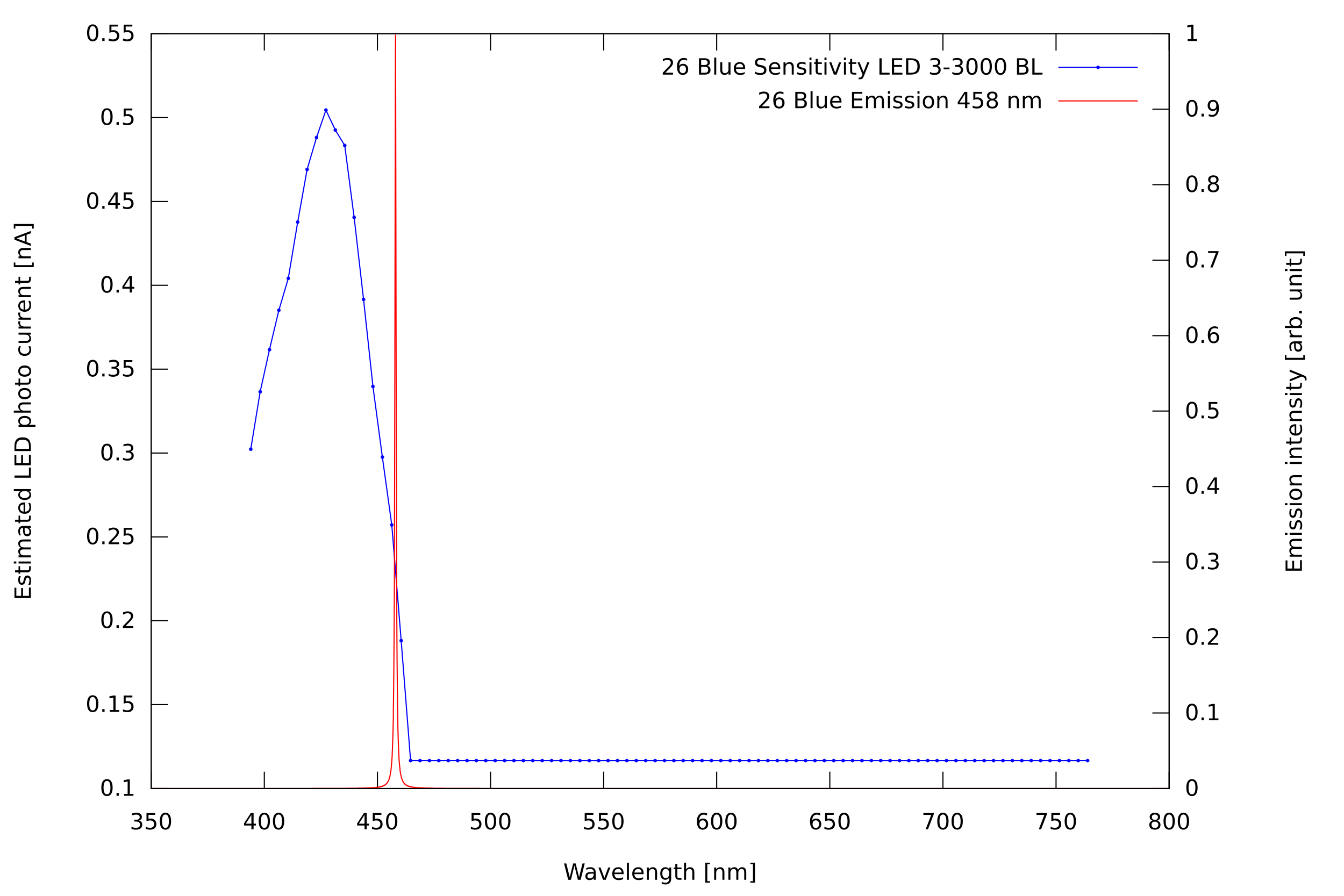
Sensitive for UV to deep blue, with (small) overlap of its peak emission wavelength with sensitivity spectrum, which is uncommon for blue LEDs.
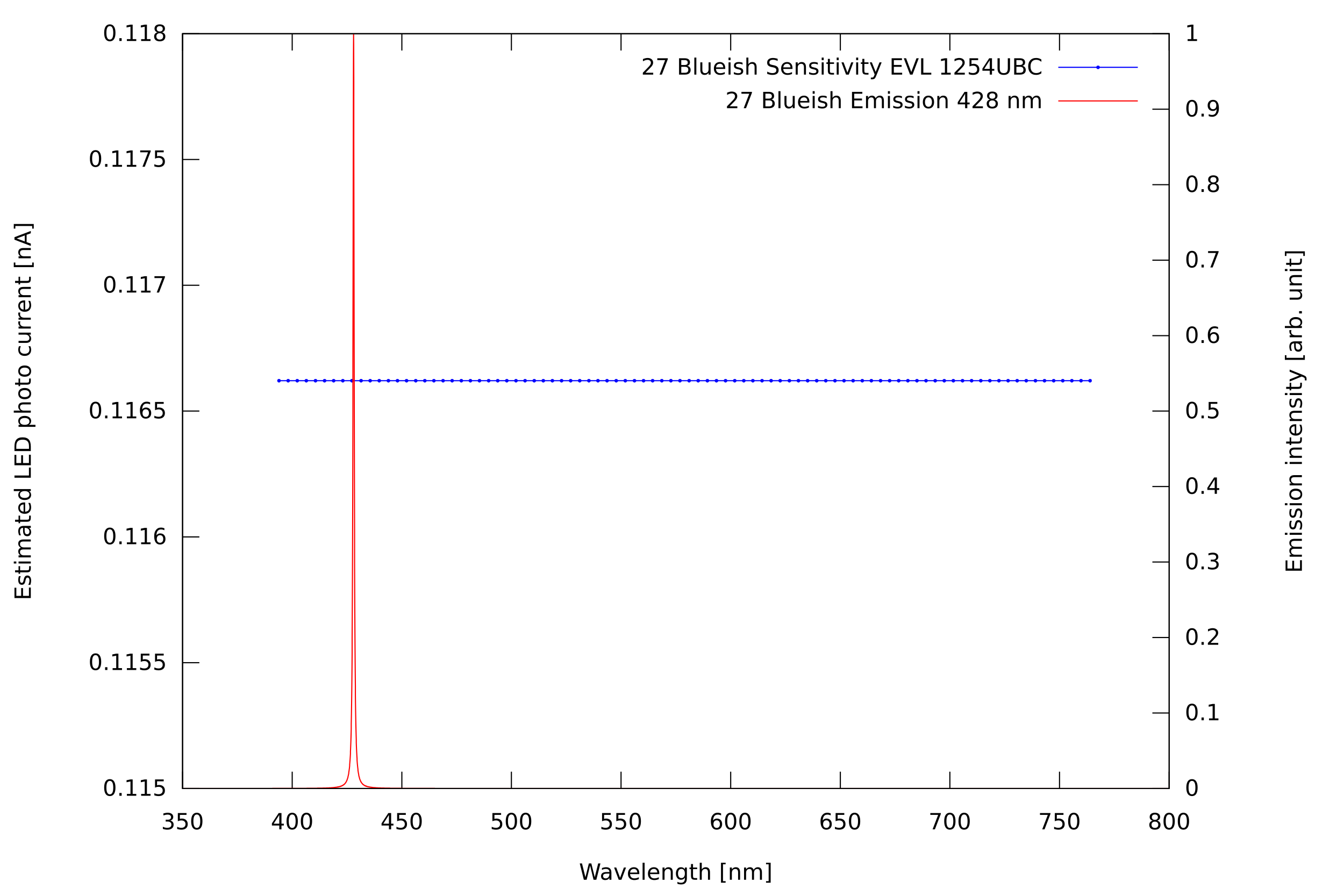
Deep-blue LED, no sensitivity found, despite being sensitive to sunlight. Deep UV-sensitive, probably.

UV-LED, emission peak wavelength close to the border of the monochomator. Its sensitivity must be deep in UV.
 Matthias Koch
Matthias Koch
Discussions
Become a Hackaday.io Member
Create an account to leave a comment. Already have an account? Log In.